Affiliate disclosure: This post may contain affiliate links. Please see our Privacy Policy.
Saint John’s wort oil (and salve) have been used for centuries to treat wounds, muscle pain, and nerve pain. It was originally used by “Saint John” for healing battlefield wounds, thus the name (in the old days, “wort” meant “plant”).
These days, St. John’s Wort is better know as a treatment for depression, taken internally in the form of tea or tincture, but it’s still an excellent topical remedy, just as it was in the time of the crusades.
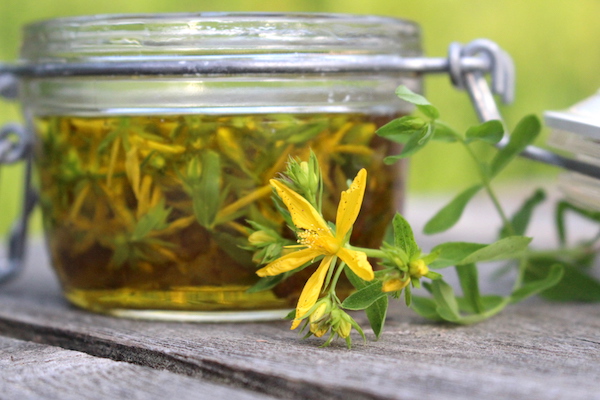
While St. Johns Wort gets a lot of press these days for its use in treating anxiety and depression, it was originally used as an oil or salve for wounds.
The name “St. John’s Wort” comes from the fact that St. John used it to treat battlefield wounds during the crusades.
It’s antimicrobial, but it also promotes wound healing and nerve repair. These days, it’s most commonly used topically for nerve issues like neuropathy and sciatica.
While it’s most commonly harvested wild, you can also grow St. Johns’ wort in your garden with these St. Johns Wort Seed Packets, so you’ll always have it fresh at hand when you need it.
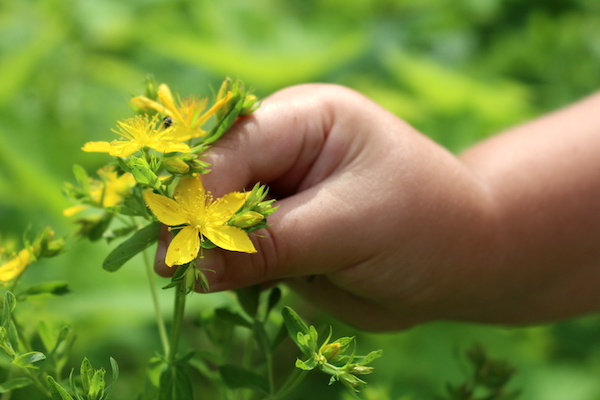
Historical Usage of St. John’s Wort
St. John’s wort has been used for at least 2,000 years for its medicinal properties, although it was more broadly administered by the Roman military to protect against witches, demons, and “evil diseases.”
Because of the herb’s bright yellow color, it was thought to be associated with the sun and therefore used for divination purposes. This usage continued over many years, and it was thought that bringing St. John’s wort into the house on the eve of midsummer could protect against all manner of evil, including protection against witches, while also encouraging good fortune while at the same time preventing house fires.
The name St. John’s wort comes from the plant’s flowering period, around the summer solstice, which also happens to fall close to St. John’s day in the calendar (on June 24th). It was reputedly used by St. John to heal battlefield wounds, specifically as St. John’s wort oil.
St. John’s wort was considered such a powerful herb that there are reports of it being used to rid a house of a poltergeist in London, England at the end of the 17th century.
Apparently, all that was needed to get rid of the spirit was some St. John’s wort tucked under the pillow of the home’s owner, a good tip to remember if you’re ever in need an herbal remedy to exorcise a supernatural presence from your house — I’m sure St. John’s wort oil would work just as well, but don’t quote me on that.
In terms of (actual) practical usage, St. John’s wort was carried by crusaders so that they could treat wounds both on and off the battlefield. Over time and throughout the ages, its healing benefits would go on to include relief for burns, snakebites, upset stomach, fractures, menstrual cramping, lung ailments, exhaustion, and kidney disease.
While some of these uses have fallen out of fashion, St. John’s wort is still valued today (in both the naturopathic and medical community) for its proven effect on depression, anxiety, and wound healing.
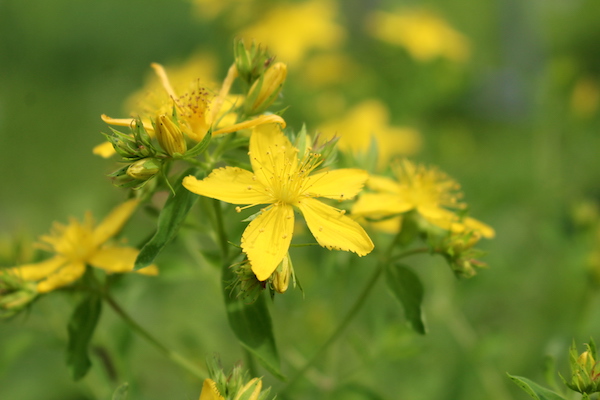
St. John’s Wort Oil Benefits
When applied as an oil or tincture, St. John’s wort is used to treat all manner of skin conditions, including minor wounds and burns, bruises, and skin ulcers.
St. John’s wort is also being studied in a clinical capacity for its anti-inflammatory, anticancer, antioxidant, and antimicrobial properties. Additionally, “sporadic trials have been conducted in wound healing, atopic dermatitis, psoriasis, and herpes simplex infections, partly with purified single constituents and modern dermatological formulations.”
When research is conducted on St. John’s wort, the focus is almost always on the herb’s antidepressant effects — there’s very little available published material that concentrates on its strength as a wound-healing agent.
However, early research by Russian scientists isolated the antibacterial component hyperforin as being the main antibacterial mechanism in St. John’s wort.
Hyperforin has been shown to inhibit the growth of certain types of micro-organism, particularly Staphylococcus aureus, a type of bacteria found on the skin and in the upper respiratory tract that is resistant to penicillin.
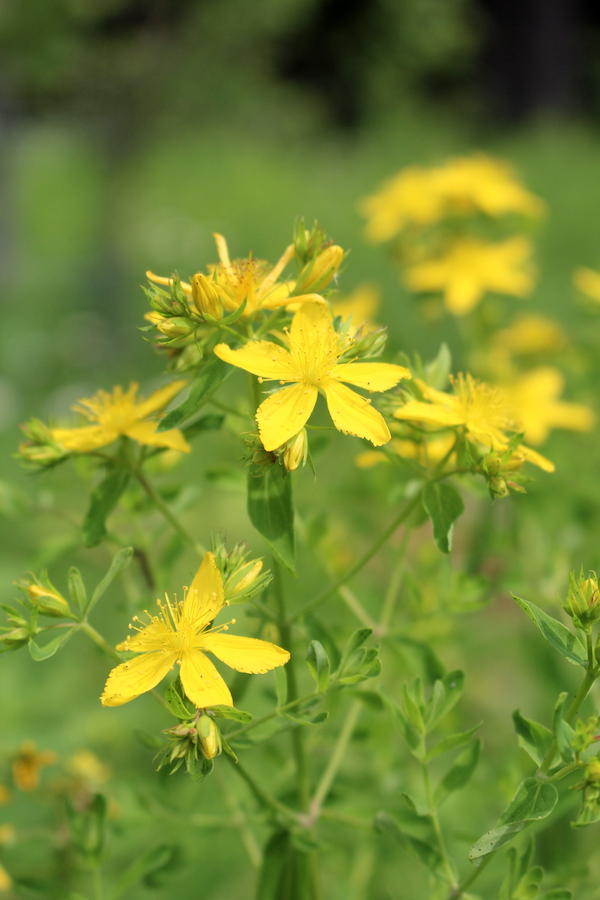
Identifying St. John’s Wort
The scientific name for St. John’s wort, Hypericum perforatum, provides an important clue for identifying the herb in the wild. The word “perforatum” is related to the word “perforated,” which makes sense once you’re aware of the tiny perforated holes on the leaves of this plant (which are actually near-microscopic translucent spots with glandular tissue).
If you hold the leaves up to a light source, you’ll notice the small green leaves look as though they’re glowing. This is actually the best way to identify St. John’s wort, but because the holes are so small they can be hard to spot in the first place.
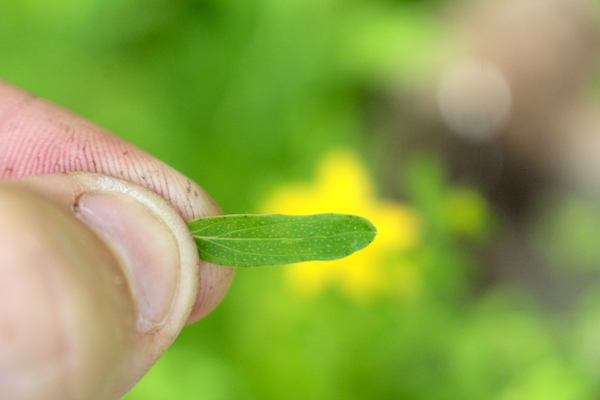
So what are some other ways you can make a positive ID?
One easy way to correctly identify St. John’s wort in the wild is by searching for their (very) hard-to-miss bright yellow blossoms — St. John’s wort flowers have 5-petaled flowers, which makes them even easier to identify.
Where I live in Vermont, the blooms are everywhere all throughout July, when we get plenty of hot weather and gorgeous sun on a daily basis. The size of the blossoms will vary, they can be anywhere from super-small to about an inch in diameter.
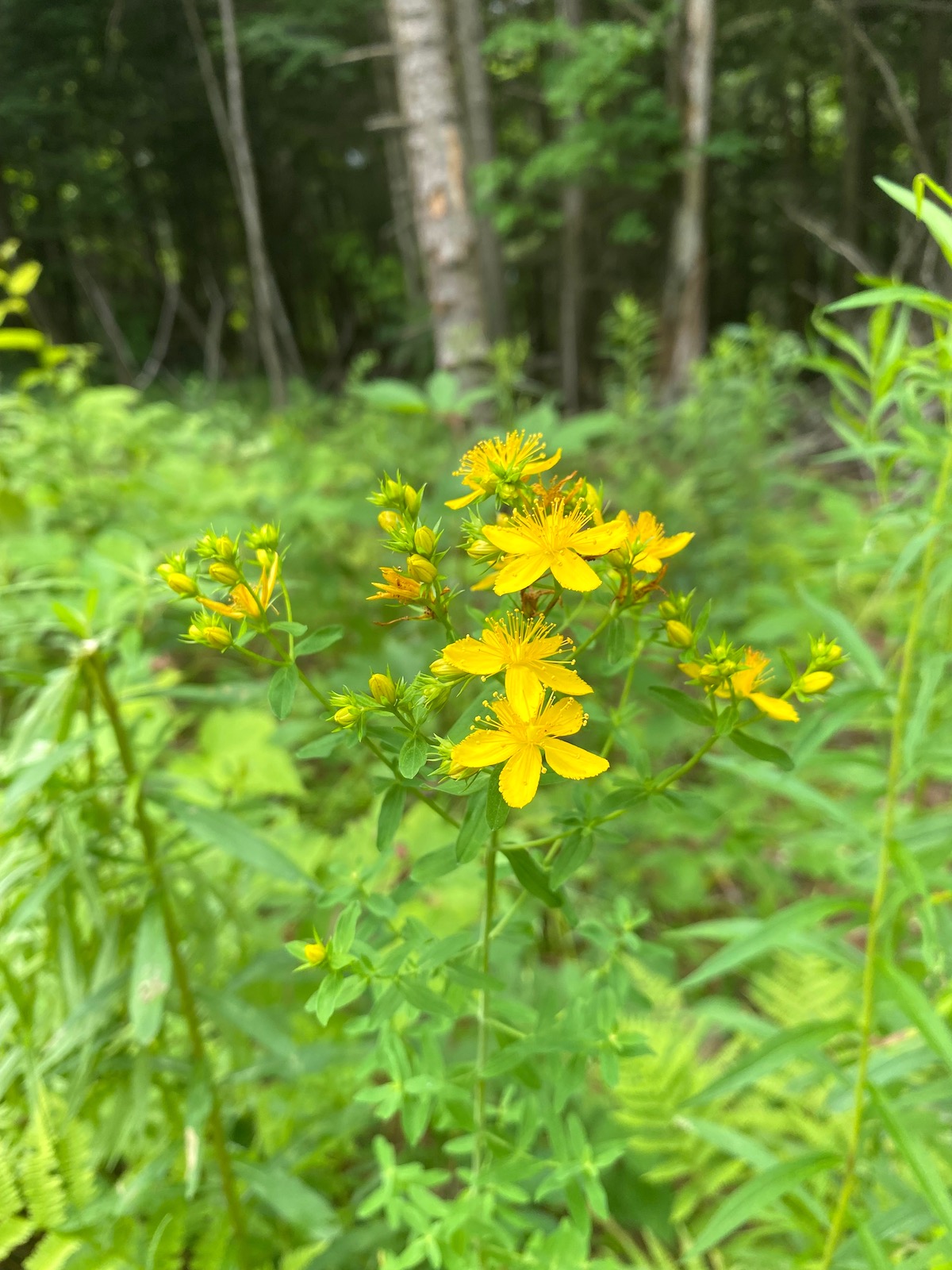
Another method you can try involves crushing the flower between two fingers. If the flowers, buds, and seed pods release a reddish-purple liquid when crushed then you’ve correctly identified St. John’s wort.
This tip really only works on dry days, not when the flowers are coated with morning dew, so don’t worry too much if you don’t see any of this reddish-purple liquid on your fingers.

The main consideration to remember when making anything with St. John’s wort is that it only retains its medicinal benefits for a short time after being pickled (in this case, by being made into oil or a salve).
If you’ve never identified St. John’s wort before and are looking for more in-depth information on the topic, I would highly recommend reading my comprehensive guide to identifying St. Johns Wort.

Making St. John’s Wort Oil
St. John’s wort oil (or any herbal remedy containing St. John’s wort) should only be made with fresh flowers, which means that the medicinal compounds need to be extracted using the “quick method” to prevent any of the ingredients from turning rancid.
To make the St. John’s oil, begin with the neutral carrier oil of your choice. There are several possible oils to choose from, including grapeseed, olive, jojoba, almond, or coconut oil.
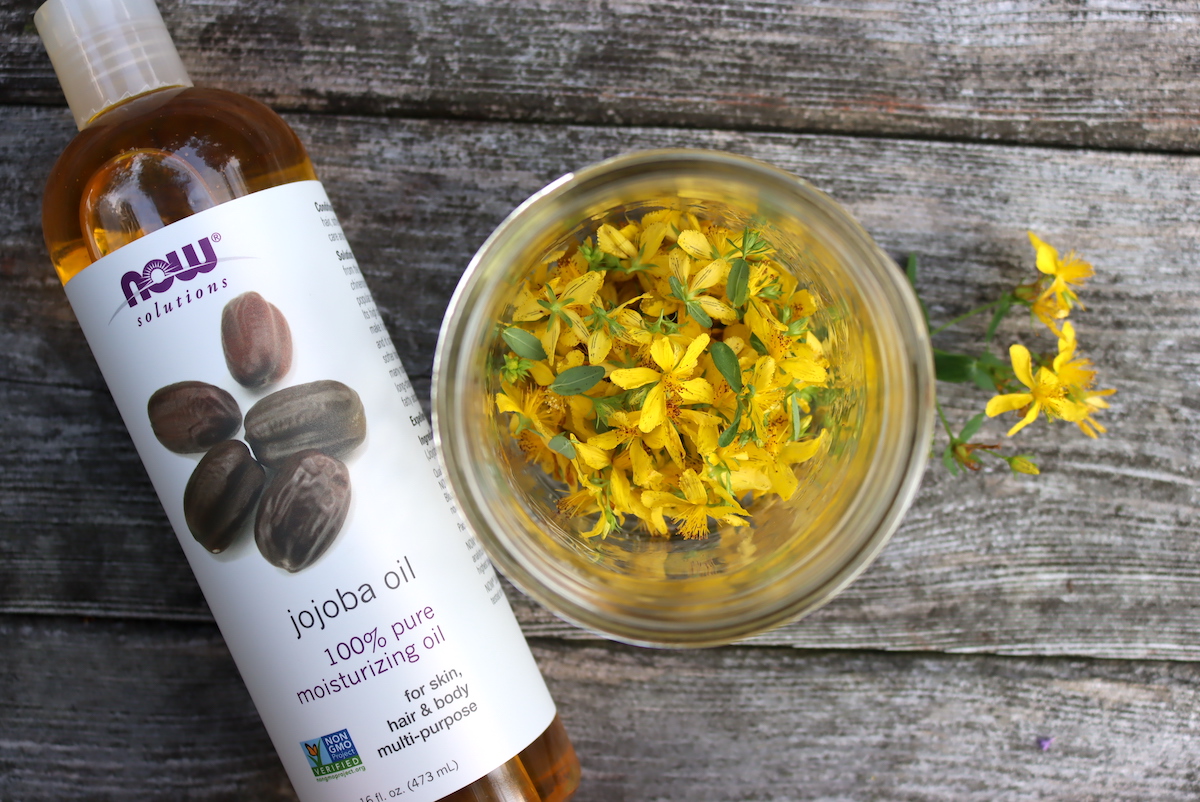
From there, you’ll need a clean, dry jar with a lid, a double boiler, a fine mesh strainer, or a funnel and cheesecloth.
To get started, fill your jar with fresh St. John’s wort blossoms, leaving 2 inches headspace at the top. Cover the herbs with the carrier oil of your choice, leaving 1 inch of headspace, and seal the jar tightly with a lid.
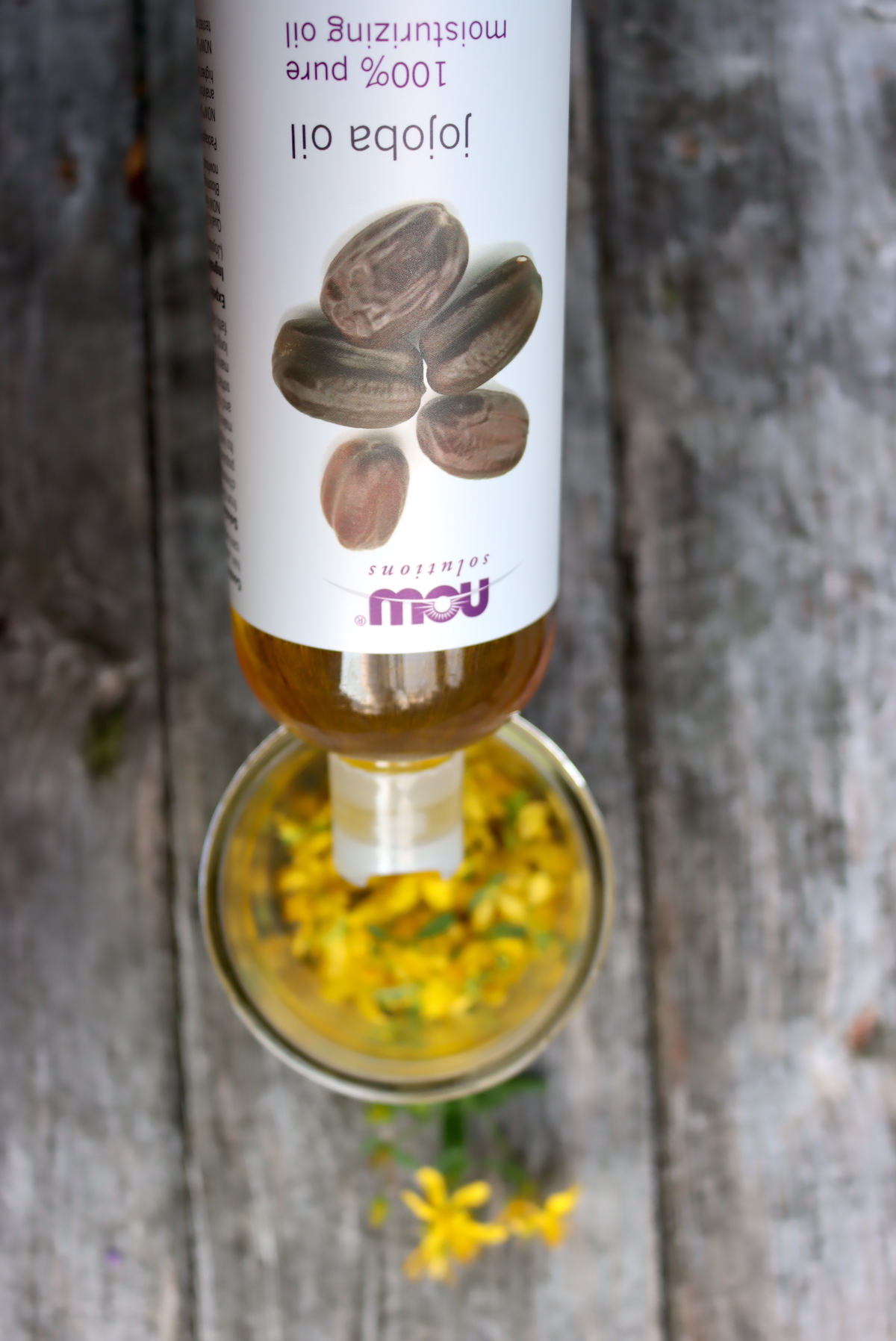
Place the sealed jar in a double boiler and infuse for 4 to 6 hours, keeping the jar’s contents at roughly 120 degrees F for the entire time (keep an eye on the water level, it will likely need to be replenished). When you’re ready to extract the oil, simply pass the contents through a cheesecloth-lined funnel or a fine mesh sieve — use your fingers to gently press on the St. John’s wort to extract as much of the liquid as possible.
Another option is to use a professional oil infuser, which quite a few people seem to have in their homes these days for making other types of “medicinal herbal oils,” mostly for edibles. Feel free to use these handy machines work for making herbal oil infusions with St. John’s wort and other herbs.
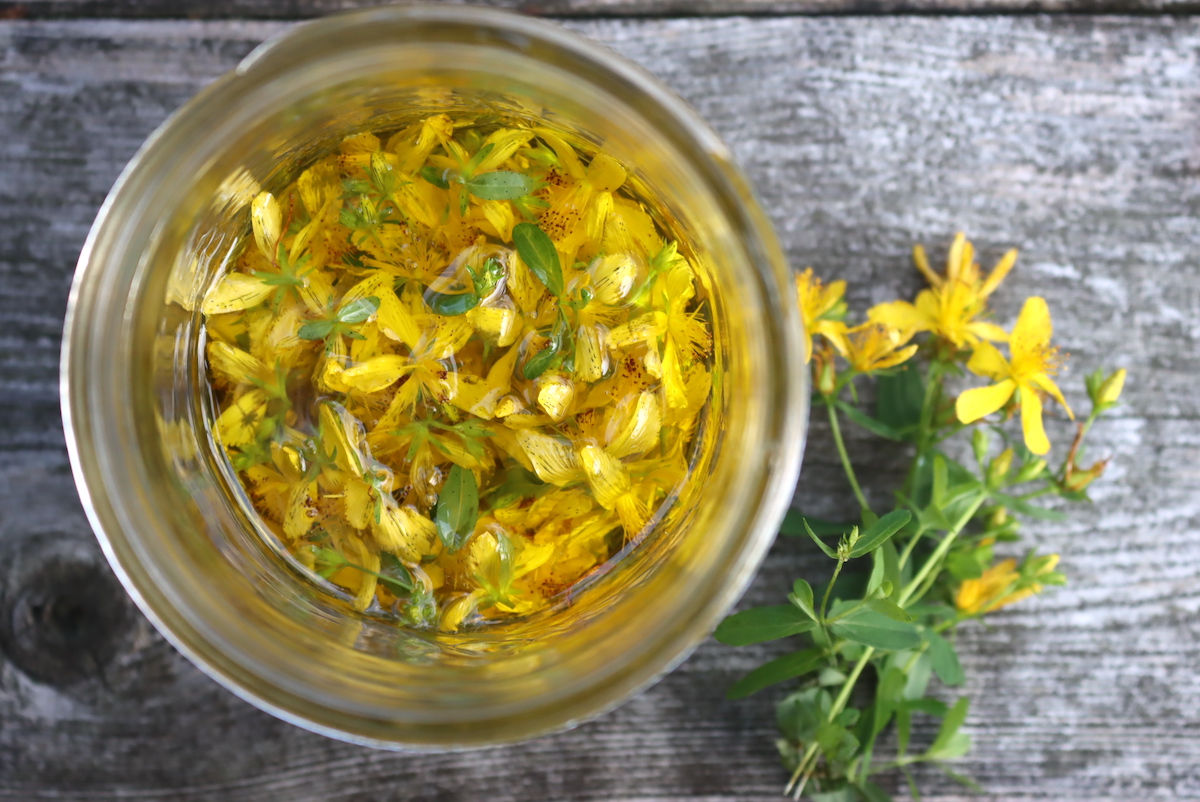
If for whatever reason your St. John’s wort oil infusion doesn’t work out, you can also purchase high-quality oil from either Herb Pharm or Mountain Rose Herbs.
Making St. Johns Wort Salve
Once you’ve made your St. John’s wort oil, you have the option of making it into a salve for wounds and other skin ailments. It only takes a couple of extra minutes, and will yield a solid salve that’s less likely to turn rancid than straight-up oil.
All you need to do is pour the oil into a heatproof bowl and place it in the same double boiler you used to make the St. John’s oil, adding about an inch of water to the boiler.
Next, you’ll add the beeswax to the oil. I like to use beeswax pistils because they’re a lot easier to weigh and measure, but if you have it in solid block form you can just cut off a section to use as needed. If you don’t have a kitchen scale, one heaping tablespoon of beeswax pistils is roughly one ounce of beeswax. How much beeswax you add will depend on whether you like a firm or more spreadable salve, but I usually go with 1 ounce of wax (weighed) for every cup or 8 ounces of herbal-infused oil.
A word on beeswax: If you use yellow beeswax, the bright red color of the oil won’t come through in the finished salve. That’s totally aesthetic and doesn’t impact the healing qualities.
Personally, I like to use white bees’ wax when making this salve so the finished salve is a beautiful bright red. White bees wax is totally natural, and it’s not treated in any way. Beeswax is actually normally white as soon as the bees make it, before they start walking on it and filling it with honey and pollen. The main difference being that white beeswax is harvested right after being made, while yellow beeswax is leftover from honey production.
Gently heat the St. John’s wort oil and beeswax mixture until the wax has completely melted. Carefully pour the liquid salve into the container of your choice and allow to firm up. I especially like using these small salve tins with lids because they’re portable and make beautiful gifts when filled with your favorite salve (or other handmade herbal remedy).
Other Ways to Use St. Johns Wort
Making oil or salve from St. John’s wort is just one use for this versatile herb (you can also try adding St. John’s wort oil to haircare products and handmade soaps!):
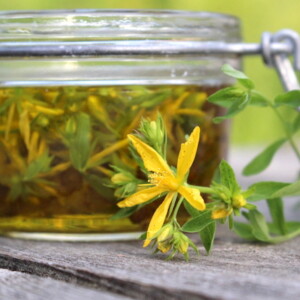
St. John’s Wort Oil (& Salve)
Equipment
- Fine mesh sieve OR cheesecloth and funnel
- Small bowl
Ingredients
- St. John’s wort blossoms freshly picked*
- Carrier oil to cover grapeseed, olive oil, and jojoba oil all work well*
- Beeswax pistils preferred
Instructions
- Add fresh St. John's wort blossoms to jar, leaving 2-inch headspace.
- Cover blossoms with carrier oil of your choice, leaving 1-inch headspace. Apply lid.
- Place the jar in a double boiler and keep at roughly 120 degrees F, infusing the oil for 4 to 6 hours (you may have to add more water to the double boiler over the infusing time).
- Remove jar from double boiler and pour oil and flowers through a fine mesh sieve or funnel lined with cheesecloth. Gently press to extract as much liquid as possible.
- To make salve, pour the St. John's wort oil into a small bowl and place back in the double boiler. Add the beeswax in the desired quantity.**
- Stirring frequently, melt the beeswax into the oil. Once fully melted, it can be decanted into small tins. Let cool and use as needed.
Notes
Homemade Herbal Remedies
Looking for more ways to stock your home herbal apothecary?
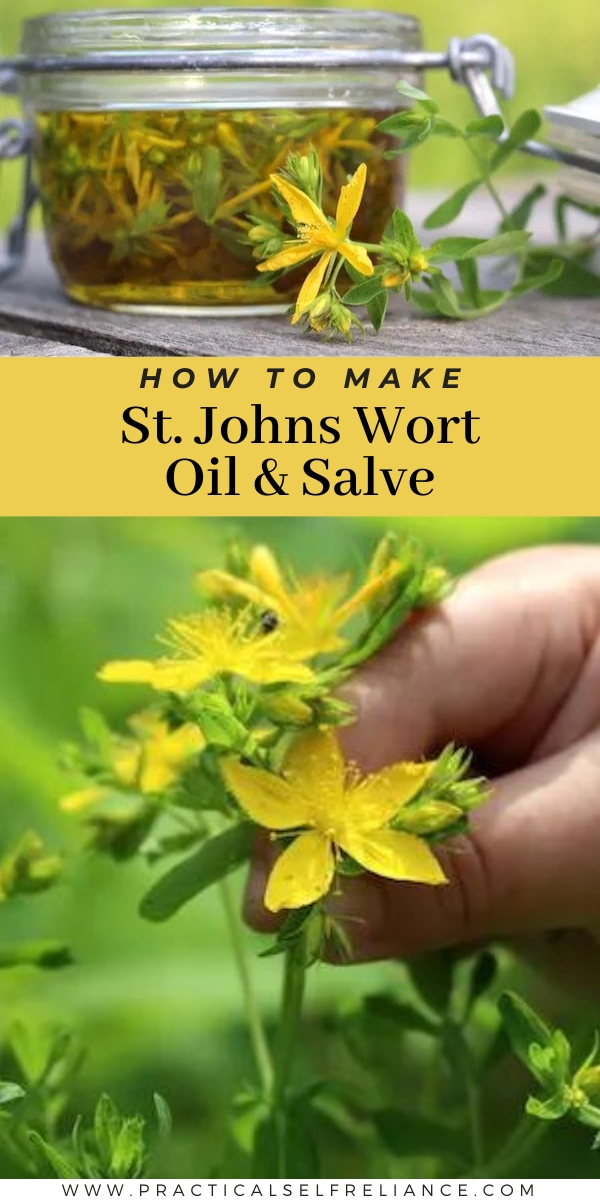
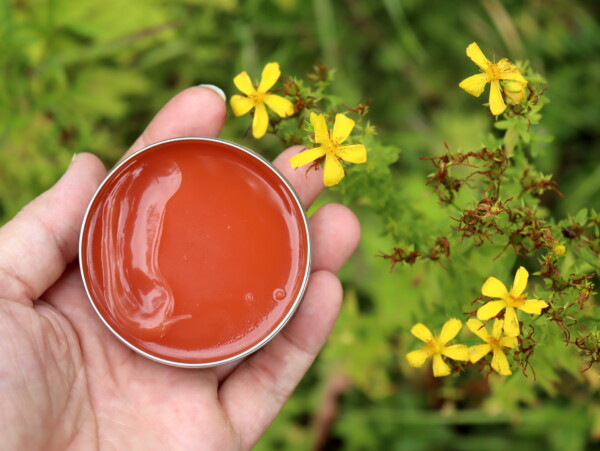

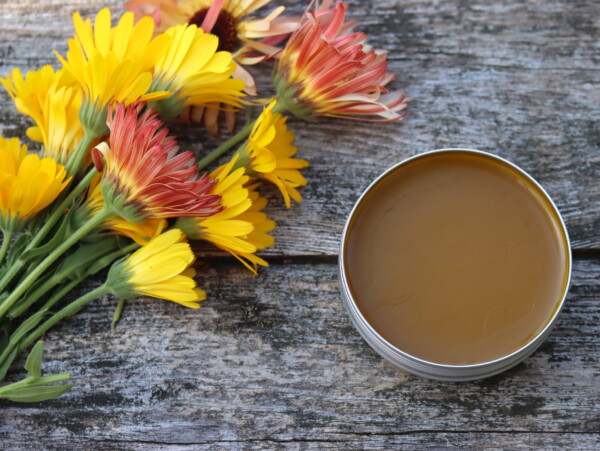
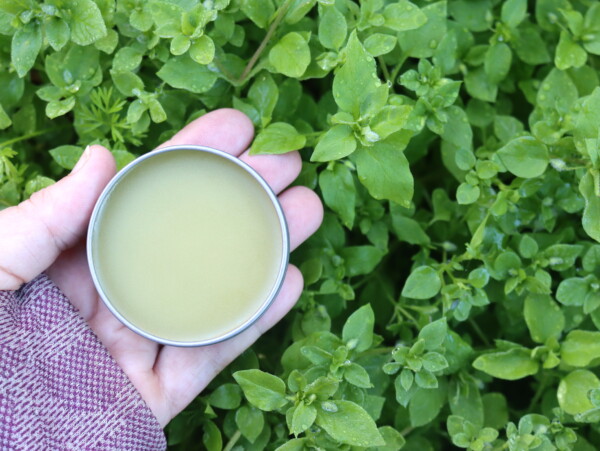
I use dried St John’s Wort. I also use the slow infusion, believing that using heat may remove beneficial properties. My question is: I’ve made St. John’s Wort before, and it turned the red color mentioned. This time, however it is just green. Did I do something wrong? The SJW is good quality, and I used a good olive oil just like I did the first time…I’m wondering what I did wrong and will it be just as good if it didn’t turn the ’traditional’ red color. I’m making it for my homemade “Trauma oil” 1 part St. John’s Wort oil 1 part arnica oil, 1 part calendula oil.
In order to get the red color, you want to use fresh rather than dried St. John’s Wort.
I rarely have access to fresh herbs. I used dried last time as well, and still got the traditional red color…
Please readjust the font size. Your comments are teeny-tiny font, making it difficult for those with less than perfect eyesight to use correctly.
There are phytochemicals in the plant which are transferred into the oil during extraction. The phenolic compounds which are similar to hypericin are what give the oil its red color and also are believed to be responsible for the antidepressant qualities. As the plant dries, these compounds are often lost which is why a fresh infusion is usually recommended. It’s possible that the freshness of your dried plant material could be different. It has also been shown in studies that the temperature and light during the extraction time affects the color along with the type of oil that is used. I would look at your process to see if there is something different that you did with this particular batch in regards to these conditions including the freshness of your dried herb and perhaps that might give you some insight as to why this batch was different. I’m sorry but I’m not sure how to help with the comment size. On my end, the comments seem to be the same size font as everything else.
1
1
Ashley
Can you help me out with this question. I bought bronchial blend tincture from Nicole’s Apothecary. It has Lungwort Lichen (Whole Lichen) and Mullein Leaf. It is a Spagyric Extract. I’ve tried to get an answer from them on their website. But they say ask a Natural Pathocic Doctor. Says to take 40 dropperfuls 1 to 3 times per day. I’m on generic Zoloft 150 mg per day. Do u feel this is safe said lungwort is not safe some kinds.
I’m sorry but we can’t help with that information. That’s really something that should be discussed with a medical provider.